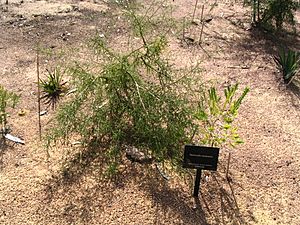Cooloomia verticordia facts for kids
Quick facts for kids Cooloomia verticordia |
|
|---|---|
 |
|
| Verticordia cooloomia plant in Kings Park, Perth, Australia. | |
| Conservation status | |
| Scientific classification | |
| Genus: |
Verticordia
|
| Species: |
cooloomia
|
Verticordia cooloomia, also known as Cooloomia verticordia, is a special flowering plant. It belongs to the myrtle family, called Myrtaceae. This plant is found only in the south-west part of Western Australia. It grows as an open, spreading shrub. Its yellow flowers have a strong, sharp scent. You can find this plant mainly near the Cooloomia Nature Reserve and the Murchison River.
Contents
What Does Cooloomia Verticordia Look Like?
Verticordia cooloomia is a shrub that branches out widely. It grows from a single stem at its base. This plant can reach about 2.5 meters (8 feet) tall. It can also spread out to about 3.0 meters (10 feet) wide.
The leaves on the lower part of the plant are long and thin. They are shaped like a circle if you cut across them. These leaves are about 20 to 30 millimeters (about 1 inch) long. Leaves higher up the stem are shaped like a spear and are curved like a dish. They are shorter, about 7 to 12 millimeters (0.3 to 0.5 inches) long. The leaves closest to the flowers are almost round. They have a pointed tip and are 3 to 6 millimeters (0.1 to 0.2 inches) across.
The Scented Yellow Flowers
The flowers have a strong, sharp smell. They grow in groups on straight stalks. These stalks are about 10 to 18 millimeters (0.4 to 0.7 inches) long. The base of the flower, called the floral cup, is shaped like a wide top. It is about 2.0 millimeters (0.08 inches) long. This part is smooth and slightly bumpy.
The sepals, which are like small leaves protecting the flower, are golden-yellow. They are about 2.0 millimeters long. Each sepal has 11 to 13 small parts with a short fringe of hairs. The petals are also golden-yellow. They are 3 to 4 millimeters (0.1 to 0.2 inches) long. The petals are almost round with an uneven, toothed edge. The style, which is part of the flower's reproductive system, is straight and smooth. It is about 3 to 5 millimeters (0.1 to 0.2 inches) long. This plant usually flowers from October to November.
Verticordia cooloomia looks a bit like Verticordia nitens, V. aurea, and V. patens. However, you can easily tell it apart. Its leaves and flowers are much larger than those other species.
How Was Cooloomia Verticordia Named?
The plant Verticordia cooloomia was first officially described in 1991. A scientist named Alex George wrote the description. He used samples collected in 1986 at Murchison House Station. Another scientist, Stephen Hopper, had found the plant earlier in 1979. He found it in the Cooloomia Nature Reserve.
The second part of the plant's name, cooloomia, comes from the name of this reserve. This is where the plant was first discovered.
Where Does Cooloomia Verticordia Grow?
This verticordia plant grows on sandy ridges. It lives in areas with heath and shrubland. These places are found near the lower parts of the Murchison River. It is part of a plant community called the Shark Bay tree heath.
Is Cooloomia Verticordia Protected?
The Western Australian Government's Department of Parks and Wildlife lists Verticordia cooloomia as "Priority Three". This means that we don't know much about this plant. It is found in only a few places. However, it is not in immediate danger of disappearing.
Growing Cooloomia Verticordia in Gardens
Many people describe Verticordia cooloomia as a "very ornamental" plant. Some even call it a "spectacular shrub." It looks especially good when planted near large rocks.
People usually grow new plants from small pieces cut from an existing plant. This is called propagating from cuttings. The plant can grow in many different types of soil and weather conditions. But it needs lots of sunshine to flower well. It doesn't like fertilizers that contain phosphorus. However, it can handle dry periods well. It also recovers nicely if you trim it after it gets damaged by very cold weather.


